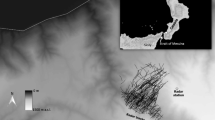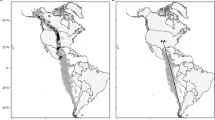Abstract
Tailwind drift compensation serves to maximize a migrant's flight distance on a given amount of energy, and crosswind drift compensation serves to hold a course true and minimize the distance flown. With full or part compensation, airspeeds are predicted to increase with greater crosswind drift. To test whether migrating dragonflies compensated for wind drift, I measured the velocity and heading of Pantala hymenaea and P. flavescens in natural flight over a lake and the ambient wind speed and direction. P. hymenaea flew north-easterly (58°), whereas P. flavescens flew significantly more east–north easterly (74°) throughout the day. Pantala spp. demonstrated part compensation for changes in crosswind drift within individuals (mean compensation = 54%, P = 0.0000), evidence for use of a ground reference to correct for drift when flying over water. Among individuals, P. flavescens compensated for crosswind drift. P. hymenaea overcompensated and then drifted downwind on one morning and compensated for crosswind drift on the next. As predicted from optimal migration theory, airspeed (5.0 m/s for both species with no tailwind) decreased with tailwind velocity both among individuals (data for both species pooled [n = 19], P < 0.0001) and within each individual as it crossed the lake (P = 0.0016).
Similar content being viewed by others
References
Alerstam, T. (1979). Wind as a selective agent in bird migration. Ornis Scand. 10: 76–93.
Alerstam, T., and Hedenström, A. (1998). The development of bird migration theory. J. Avian Biol. 29: 343–369.
Alerstam, T., and Pettersson, S.-E. (1976). Do birds use waves for orientation when migrating across the sea? Nature 259: 205–207.
Bildstein, K. L. (1999). Racing with the sun: The forced migration of the broad-winged hawk. In Able, K. P. (ed.), Gatherings of Angels: Migrating Birds and Their Ecology, Cornell University Press, Ithaca, NY, pp. 79–102.
Clarke, R. H., Dyer, A. J., Brook, R. R., Reid, D. G., and Troup, A. J. (1971). The Wangara experiment: Boundary layer data. Division of meteorological physics technical paper 19, Commonwealth Scientific and Industrial Research Organization, Australia.
Dudley, R., and DeVries, P. J. (1990). Flight physiology of migrating Urania fulgens (Uraniidae) moths: Kinematics and aerodynamics of natural free flight. J. Comp. Physiol. A 167: 145–154.
Dudley, R., and Srygley, R. B. (1994). Flight physiology of Neotropical butterflies: Allometry of airspeeds during natural free flight. J. Exp. Biol. 191: 125–139.
Dumont, H. J., and Verschuren, D. (1991). Atypical ecology of Pantala flavescens (Fabr.) on Easter Island (Anisoptera: Libellulidae). Odonatologica 20: 45–51.
Ellington, C. P. (1991). Limitations on animal flight performance. J. Exp. Biol. 160: 71–91.
Esch, H. E., and Burns, J. E. (1996). Distance estimation by foraging honeybees. J. Exp. Biol. 199: 155–162.
Gill, A. E. (1982). Atmosphere-Ocean Dynamics, Academic Press, London.
Heran, H. (1956). Ein Beitrag zur Frage nach der Wahrnehmungsgrundlage der Entfernungsweisung der Bienen. Z. Physiol. 38: 168–218.
Pennycuick, C. J. (1978). Fifteen testable predictions about bird flight. Oikos 30: 165–176.
Richardson, W. J. (1991). Wind and orientation of migrating birds: A review. In Berthold, P. (ed.), Orientation in Birds. Birkhäuser Verlag, Basel, pp. 226–249.
Rudolph, D. C., and Fisher, C. D. (1993). Swainson's hawk predation on dragonflies in Argentina. Wilson Bull. 105: 365–366.
Russell, R. W., May, M. L., Soltesz, K. L., and Fitzpatrick, J. W. (1998). Massive swarm migrations of dragonflies (Odonata) in eastern North America. Am. Midl. Nat. 140: 325–342.
Srygley, R. B. (2001a). Sexual differences in tailwind drift compensation in Phoebis sennae butterflies (Lepidoptera: Pieridae) migrating over seas. Behav. Ecol. 12: 607–611.
Srygley, R. B. (2001b). Compensation for fluctuations in crosswind drift without stationary landmarks in butterflies migrating over seas. Anim. Behav. 61: 191–203.
Srygley, R. B., and Dudley, R. (1993). Correlations of the position of center of body mass with butterfly escape tactics. J. Exp. Biol. 174: 155–166.
Srygley, R. B., and Oliveira, E. G. (2001). Migration patterns and orientation mechanisms within the flight boundary layer. In Woiwod, I., Reynolds, D., and Thomas, C. D. (Eds.), Insect Movement: Mechanisms and Consequences, CAB International, Oxford, pp. 183–206.
Srygley, R. B., Oliveira, E. G., and Dudley, R. (1996). Wind drift compensation, flyways, and conservation of diurnal, migrant Neotropical Lepidoptera. Proc. Roy. Soc. Lond. B 263: 1351–1357.
Wakeling, J. M., and Ellington, C. P. (1997). Dragonfly flight. III. Lift and power requirements. J. Exp. Biol. 200: 583–600.
Author information
Authors and Affiliations
Corresponding author
Rights and permissions
About this article
Cite this article
Srygley, R.B. Wind Drift Compensation in Migrating Dragonflies Pantala (Odonata: Libellulidae). Journal of Insect Behavior 16, 217–232 (2003). https://doi.org/10.1023/A:1023915802067
Issue Date:
DOI: https://doi.org/10.1023/A:1023915802067




